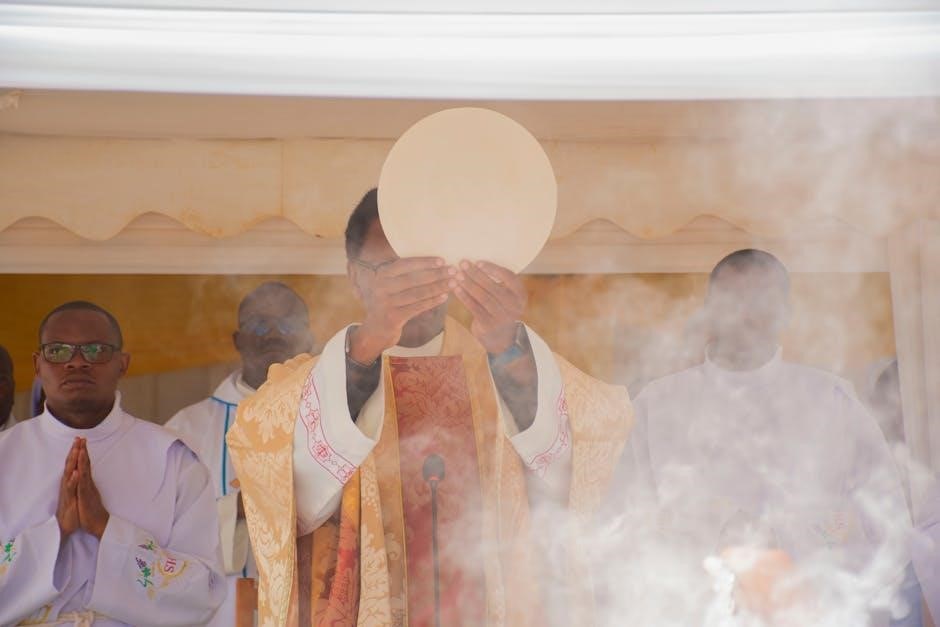communion to the sick pdf
The Communion to the Sick is a sacred sacrament offering spiritual nourishment to the ill or homebound, rooted in biblical teachings of healing and Christ’s Last Supper. This rite provides comfort, grace, and a connection to the Eucharistic celebration, emphasizing God’s healing presence. Historically, it has evolved from early Church practices to today’s pastoral care, administered by priests, deacons, or trained lay ministers as a testament to faith and compassion.
1.1. Overview of the Sacrament
The sacrament of Communion to the Sick is a liturgical rite that extends the Eucharistic celebration to those unable to participate due to illness or frailty. It is rooted in Christ’s command to care for the sick and serves as a source of spiritual strength and healing; The sacrament involves the administration of the Eucharist, often accompanied by prayers, readings, and devotions. It emphasizes the unity of the Church and offers comfort to the sick, reaffirming their place within the faith community. This sacred ritual is a profound expression of God’s love and mercy.
1.2. Importance of Communion for the Sick
Communion for the sick holds profound spiritual significance, offering solace and grace to those in need. It strengthens their faith, provides comfort, and fosters a sense of unity with the Church. The sacrament serves as a reminder of Christ’s healing presence and love, especially during times of suffering. By receiving the Eucharist, the sick are spiritually nourished and empowered, reaffirming their hope and trust in God’s providence. This sacred act is a vital pastoral service, demonstrating compassion and care for the vulnerable.
1.3. Historical Context
The practice of Communion to the Sick traces its roots to the early Christian Church, where the apostles ministered to the sick as part of their spiritual care. The Eucharist was seen as a source of healing and strength, with biblical accounts like the Last Supper forming its foundation. Over centuries, the rite evolved, influenced by liturgical traditions and pastoral needs. Historical documents, such as those from the Alcuin Club, highlight the sacrament’s development, emphasizing its role in providing spiritual comfort and unity with the Church for those unable to participate in communal worship.

Theological Background
The Eucharist serves as a source of healing and grace, deeply rooted in Christ’s sacrifice. It offers spiritual strength and comfort to the sick, embodying God’s love and mercy.
2.1. Biblical Foundations
The administration of Communion to the sick finds its roots in the New Testament, where Jesus often healed the sick and shared meals with them, symbolizing divine love. The Last Supper, where Christ instituted the Eucharist, is a central event, emphasizing unity and spiritual nourishment. The apostles continued this ministry, caring for the sick and offering prayers for their healing, as noted in the New Testament. This practice reflects God’s compassion and the belief in the healing power of the Eucharist, serving as a testament to Christ’s enduring presence in the lives of the faithful.
2.2. The Role of the Eucharist in Healing
The Eucharist plays a vital role in the spiritual and emotional healing of the sick, offering comfort, grace, and strength. It is a sacrament of unity, connecting the sick to the Church and to Christ, who is the ultimate healer. The Eucharist brings solace to the suffering, reminding them of God’s love and presence. This sacred act symbolizes spiritual nourishment and renewal, fostering hope and peace in times of frailty, and is deeply rooted in the belief that Christ’s Body and Blood have the power to heal both soul and body.
2.3. The Concept of Viaticum
Viaticum, meaning “provisions for the journey,” is the final Communion administered to the dying or gravely ill. It signifies spiritual strength for the passage to eternal life, offering pardon for sins and comfort in the face of death. This ancient practice, rooted in Christian tradition, emphasizes Christ’s presence during life’s final moments, providing solace and hope. Viaticum is a profound expression of God’s mercy, preparing the soul for its ultimate encounter with Him.

Preparation for Administering Communion to the Sick
Preparation involves spiritual readiness, proper use of the pyx for carrying the Eucharist, and wearing appropriate vestments. Training for ministers ensures dignity and reverence in the rite.
3.1. Spiritual Preparation of the Minister
Spiritual preparation is crucial for ministers administering Communion to the sick. It involves prayer, reflection, and seeking divine guidance to ensure they serve as vessels of Christ’s love. Ministers should approach the task with humility, ensuring their hearts are centered on God. This preparation helps them convey the sacrament’s grace and comfort effectively, fostering a deep connection between the sick and the Eucharistic celebration. Proper spiritual readiness ensures the minister’s actions radiate compassion and reverence, embodying Christ’s healing presence.
3.2. Material Preparation (e.g., Pyx, Vestments)
Material preparation is essential for administering Communion to the sick. A pyx, a small, consecrated container, is used to carry the Blessed Sacrament. Ministers should ensure the pyx is clean and securely closed. Vestments, such as an alb and stole, are worn to signify the sacred nature of the ministry. Holy water, a prayer book, and a crucifix may also be carried. A briefcase or case with compartments can help organize these items. Proper preparation ensures the rite is conducted with reverence and dignity, reflecting the Eucharist’s sanctity and the minister’s devotion.
3.3. Training for Extraordinary Ministers
Training for Extraordinary Ministers emphasizes understanding the sacrament’s significance, practical skills, and pastoral care. Ministers learn to conduct the rite reverently, handle the Eucharist with devotion, and provide emotional and spiritual support. Instruction includes familiarity with liturgical texts, proper use of the pyx, and maintaining a prayerful demeanor. Ongoing education ensures ministers stay updated on liturgical guidelines and deepen their spirituality. This formation equips them to serve the sick with compassion, ensuring the sacrament is administered with dignity and grace, while fostering a profound connection to Christ and the Church.

The Rite of Communion to the Sick
The Rite of Communion to the Sick includes introductory rites, the Liturgy of the Word, the celebration of the Eucharist, and concluding prayers, providing spiritual comfort.
4.1. Introductory Rites
The introductory rites prepare the sick person and others present for the sacred moment of Communion. They begin with a greeting, such as “The grace of our Lord Jesus Christ be with you,” followed by a prayer of faith and invocation of blessings. The rites may include a brief period of silence, a penitential act, or a prayer for healing, setting a tone of reverence and spiritual readiness. These rites are designed to focus the minds and hearts of all on the sacredness of the Eucharist and its life-giving power for the sick. The Blessed Sacrament is then reverently presented, and the sick person may renew their baptismal promises, deepening their spiritual connection to Christ and the Church. These introductory elements create a meaningful and prayerful atmosphere, ensuring that the Communion to the Sick is received with the proper disposition and devotion. Through these rites, the sick are reminded of God’s love and mercy, and the community is united in prayer and support for their recovery and spiritual well-being.
4.2. Liturgy of the Word
The Liturgy of the Word in the Communion to the Sick includes a reading from Scripture, often selected from Sunday’s liturgy, and a period of prayer. The Minister may lead the sick person in reflections or intercessions, fostering spiritual connection. The Lord’s Prayer is typically recited, emphasizing unity with Christ and the Church. This part of the rite provides comfort, grace, and spiritual nourishment, reminding the sick of God’s healing love and presence in their lives. The Word of God strengthens their faith and offers hope for recovery and eternal life.
4.3. Celebration of the Eucharist
The Celebration of the Eucharist in the rite of Communion to the Sick involves the Minister presenting the Blessed Sacrament to the sick person. The Minister says, “The Body of Christ,” to which the recipient responds, “Amen,” and receives Holy Communion. This sacrament symbolizes unity with Christ and the Church, offering spiritual strength and healing. Prayers of thanksgiving and intercession follow, invoking God’s mercy and grace. The Eucharist is a profound moment of faith, reinforcing the belief in Christ’s redemptive love and the hope of eternal life, even in times of illness or frailty.
4.4. Concluding Rites
The concluding rites bring closure to the Communion service, emphasizing spiritual renewal and hope. The Minister leads prayers of thanksgiving, invoking God’s continued healing presence. Intercessions may be offered for the sick person, their loved ones, and the broader community. The rite concludes with a dismissal, such as “Go in peace,” reinforcing the sick person’s connection to Christ and the Church. These final moments provide comfort, reaffirming God’s enduring love and grace, even in times of illness or frailty.

Guidelines for Administering Communion
Proper procedures ensure the sacredness of the Eucharist when administered to the sick, emphasizing reverence, hygiene, and adherence to liturgical norms by ordained ministers and trained laypersons.
5.1. Role of the Priest or Deacon
Priests and deacons hold the primary responsibility for administering the Eucharist to the sick, serving as Christ’s representatives. They lead the liturgical rites, offer prayers for healing, and ensure the sacrament’s proper handling. Their role involves spiritual preparation, including prayer and reflection, to convey God’s grace and compassion effectively. Additionally, they provide pastoral care, offering emotional and spiritual support to the sick, and may also administer the sacrament of the Anointing of the Sick when appropriate, emphasizing the Church’s commitment to holistic healing and divine mercy.
5.2. Role of Extraordinary Ministers
Extraordinary Ministers of Holy Communion (EMHCs) are laypersons authorized to bring the Eucharist to the sick and homebound. They serve as Christ’s ambassadors, offering spiritual support and connecting the sick to the larger faith community. EMHCs lead prayers, distribute Communion, and provide emotional comfort. Proper training and parish authorization are essential for this ministry. While they cannot administer the Sacrament of the Anointing of the Sick, their role is vital in ensuring the sick experience God’s presence and grace through the Eucharist, fostering a sense of belonging and spiritual renewal.
5.3. Special Considerations for the Homebound
Ministering to the homebound requires sensitivity to their unique circumstances, ensuring they feel connected to the Church despite physical limitations. Ministers should prepare by bringing necessary materials like the Blessed Sacrament, prayer books, and a briefcase for the Eucharist. Privacy and comfort are paramount; visits should be conducted in a respectful and dignified manner. Additional prayers and devotions may be included to enrich the experience, offering emotional and spiritual support. Collaboration with parish staff and regular communication with families can enhance the effectiveness of this vital ministry, ensuring the homebound receive the grace of Communion and feel the love of Christ.

Prayers and Devotions
Prayers for the sick include intercessions, the Lord’s Prayer, and specific liturgical texts, fostering spiritual comfort and faith. Devotions like the Rosary and Divine Mercy chaplet enrich the experience.
6.1. Prayers for the Sick
Prayers for the sick are central to the Communion rite, offering spiritual solace and healing. The Lord’s Prayer, intercessions, and specific liturgical texts are recited, emphasizing God’s mercy and grace. The Confiteor and prayers of thanksgiving are often included, fostering repentance and gratitude. These prayers not only comfort the sick but also strengthen their faith and connection to the divine. Ministers guide the sick in participation, ensuring a meaningful and reverent experience. Such devotions reflect the Church’s compassion and commitment to spiritual healing.
6.2. Liturgical Texts for the Rite
Liturgical texts for Communion to the Sick include specific prayers and formulas that guide the rite. The Greeting, Prayer of Thanksgiving, and the Lord’s Prayer are central, emphasizing healing and divine presence. Intercessions for the sick and the community are also included, along with sacred Scripture readings. The texts are designed to comfort the sick, affirm their faith, and strengthen their spiritual bond with the Church. These liturgical elements ensure the rite is conducted with reverence and fidelity to tradition, fostering a profound encounter with Christ.
6.3. Devotional Practices
Devotional practices surrounding Communion to the Sick include prayers, reflections, and acts of faith that deepen the recipient’s spiritual encounter. Ministers often prepare with personal prayer, while the sick may engage in quiet reflection or recite devotional texts. The rite may incorporate the Lord’s Prayer, intercessions, and renewal of baptismal promises, fostering a sense of connection to the Church. These practices emphasize the healing power of the Eucharist and offer comfort, strength, and spiritual nourishment to those unable to participate in communal worship.

The Role of Ministers
Ministers, including priests, deacons, and extraordinary ministers, play a vital role in administering Communion to the Sick, ensuring the sacrament is delivered with dignity, compassion, and spiritual care.
7.1. Clergy and Their Responsibilities
Clergy, including priests and deacons, hold a sacred duty to administer Communion to the Sick, ensuring the sacrament is delivered with reverence and compassion. They lead the Liturgy of the Word, offer prayers for healing, and provide spiritual comfort. Clergy are responsible for preparing the Eucharist, ensuring its proper handling, and guiding the sick in renewing their faith. Their role extends beyond the sacrament, offering emotional and spiritual support, and praying for the sick’s recovery and strength. Their ministry reflects Christ’s healing presence and care for the vulnerable.
7.2. Lay Ministers and Their Role
Lay ministers, as Extraordinary Ministers of Holy Communion (EMHCs), play a vital role in bringing the Eucharist to the sick and homebound. Trained and commissioned, they represent the parish community, offering spiritual support and fostering a sense of connection. Their responsibilities include reverently transporting the Blessed Sacrament, leading prayers, and ensuring the rite is conducted with dignity. EMHCs provide comfort, listen to the sick, and share in their faith journey, embodying Christ’s compassion and the Church’s care for its members. Their ministry is a testament to the power of communal faith and service.
7.3. Formation and Ongoing Education
Formation and ongoing education are essential for ministers administering Communion to the sick. Initial training includes understanding the sacrament, liturgical guidelines, and pastoral care. Continuous education involves spiritual growth, updates on liturgical practices, and reflection on the ministry’s role. Ministers are encouraged to deepen their understanding of the Eucharist and its significance in healing. Resources like liturgical documents and pastoral guidelines are integral to their development. This ensures that ministers can provide compassionate and meaningful service, fostering a deeper connection between the sick and the Church.

Pastoral Care and Compassion
Ministers providing Communion to the sick embody Christ’s compassion, offering emotional and spiritual support. Their presence fosters a sense of community and connection to the faith.
8.1. Accompanying the Sick Spiritually
Ministers providing Communion to the sick serve as Christ’s representatives, offering spiritual support and comfort. They lead the sick in prayer, renewing baptismal promises and reciting the Lord’s Prayer, fostering a deep connection to faith. This ministry not only provides solace but also strengthens the sick person’s spiritual bond with the Church, reminding them of God’s healing presence and grace. The rite includes specific prayers and rituals, ensuring the sick feel accompanied and valued, even in their vulnerability, while maintaining a sense of community and connection to the Eucharistic celebration.
8.2. Emotional and Spiritual Support
Administering Communion to the sick provides profound emotional and spiritual support, offering comfort and peace in times of vulnerability. The Eucharist strengthens their faith, reminding them of God’s love and presence. Ministers play a crucial role in this ministry, not only through the sacrament but also through their compassionate presence and listening ear. This support helps the sick feel connected to their faith community, fostering hope and resilience. It also underscores the Church’s commitment to caring for the whole person—body, mind, and spirit—during challenging times, ensuring they are not alone in their journey toward healing and grace.
8.3. Building a Community of Care
Communion to the sick fosters a community of care, connecting the ill to the broader parish family. Eucharistic ministers visit the sick, sharing the Eucharist and praying together, which strengthens spiritual bonds. This ministry highlights the Church’s commitment to inclusivity and compassion, ensuring no one feels isolated. It encourages collective prayer and support, creating a network of care that uplifts both the sick and the community. Through this shared sacramental experience, the parish embodies Christ’s command to “love one another,” fostering unity and hope in times of need.

The Impact of Communion to the Sick
Communion to the sick brings spiritual comfort, strengthens faith, and fosters a sense of community, ensuring the ill feel connected to the Church’s life and supported.
9.1. Spiritual Comfort for the Sick
Receiving Communion brings profound spiritual comfort to the sick, offering solace, peace, and strength. It reminds them of God’s loving presence and care, even in illness. The Eucharist provides nourishment for the soul, fostering hope and trust in divine healing. This sacrament also strengthens their connection to the faith community, ensuring they feel united with others in prayer and worship. For many, it is a source of emotional and spiritual renewal, helping them face challenges with grace and resilience.
9.2. Strengthening Faith
Communion to the sick strengthens faith by providing a tangible reminder of God’s presence and love. The Eucharist serves as spiritual nourishment, renewing hope and trust in divine providence. For the ill, receiving Communion can deepen their belief in Christ’s healing power and His promise of eternal life. It also fosters a sense of unity with the Church, reminding them they are not alone in their journey. This sacrament becomes a powerful source of consolation, reinforcing their faith and helping them face challenges with greater resilience and trust in God’s plan.
9.3. Fostering a Sense of Community
Communion to the sick fosters a sense of community by connecting the isolated to the broader Church family. Ministers who bring the Eucharist act as bridges, reminding the sick they are not forgotten. This sacrament strengthens bonds, as the community prays for and supports its members, reinforcing unity in faith. It also encourages compassion and care, reflecting Christ’s command to love one another. Through this shared spiritual experience, the sick feel embraced, and the community is reminded of its responsibility to uplift those in need, embodying the Body of Christ in action.

Resources and References
Key resources include the “Communion of the Sick PDF,” liturgical documents, and pastoral guidelines, providing detailed prayers, rituals, and best practices for administering the sacrament effectively.
10.1. Liturgical Documents
Liturgical documents provide foundational guidelines for administering Communion to the sick, ensuring reverence and adherence to sacred traditions. The Rite of Communion to the Sick outlines the proper procedures, prayers, and rituals, while historical texts like Special Reference to the Communion of the Sick offer insights into early Church practices. These documents emphasize the sacrament’s role in spiritual healing and its connection to the Eucharistic celebration. They also include specific prayers and readings, ensuring a unified and meaningful experience for both ministers and recipients.
10.2. Pastoral Guidelines
Pastoral guidelines for Communion to the sick emphasize compassionate care and spiritual support. Ministers are encouraged to prepare thoroughly, ensuring the sick feel connected to the faith community. These guidelines stress the importance of prayer, presence, and sensitivity to the individual’s needs. They also outline proper protocols for administering the sacrament, including the use of appropriate liturgical texts and rituals. Additionally, guidelines highlight the role of both clergy and lay ministers in providing emotional and spiritual comfort, ensuring the sacrament is administered with dignity and reverence, reflecting Christ’s healing love and Presence.
10.3. Recommended Prayers and Readings
Recommended prayers and readings for Communion to the sick include the Lord’s Prayer, penitential acts, and selections from the Rite of Communion to the Sick. Scripture readings often focus on healing and hope, such as Psalms 103 and 91, or Gospel passages like John 6. Prayers for the sick, like the “Prayer for the Healing of the Sick,” are also suggested. These texts are drawn from liturgical resources and the Bible, providing spiritual comfort and reinforcing the sacrament’s purpose of bringing grace and solace to the ill. Additional devotional practices may complement the rite, fostering deeper reflection and connection to God.
Communion to the sick remains a vital sacrament, offering spiritual strength and comfort to the ill. It reflects Christ’s compassion and the Church’s commitment to caring for the vulnerable, emphasizing faith, healing, and community.
11.1. The Enduring Importance of the Sacrament
Communion to the sick remains a cornerstone of Christian pastoral care, offering spiritual strength and comfort to those unable to participate in communal worship. Rooted in biblical teachings of healing and Christ’s command to “do this in memory of me,” the sacrament provides grace, peace, and a profound sense of connection to the Eucharistic community. By bringing the Blessed Sacrament to the sick, ministers embody Christ’s compassion and reaffirm the dignity of all believers, regardless of their physical condition, fostering hope and spiritual renewal in times of vulnerability.
11.2. Call to Serve the Sick
Serving the sick through communion is a profound call to embody Christ’s compassion and love. Extraordinary Ministers of Holy Communion (EMHC) are invited to bring spiritual comfort and grace to those unable to attend Mass. This ministry requires dedication, empathy, and proper training to ensure the sacrament is administered with reverence. By serving the sick, ministers not only provide solace but also strengthen the faith of the afflicted and foster a sense of community. This sacred duty calls for humility, prayer, and a willingness to be instruments of God’s healing presence in the lives of others.
11.3. Final Reflections
Communion to the sick is a profound expression of Christ’s boundless love and mercy. It offers spiritual strength, comfort, and hope to those in need, reminding them of God’s enduring presence. This sacrament not only nourishes the soul but also unites the faithful, fostering a sense of belonging and care within the community. As ministers and believers, we are called to embrace this privilege with compassion, ensuring the sick feel loved and supported. May this sacred rite continue to inspire hearts and deepen faith, reflecting the transformative power of the Eucharist in the lives of all it touches.